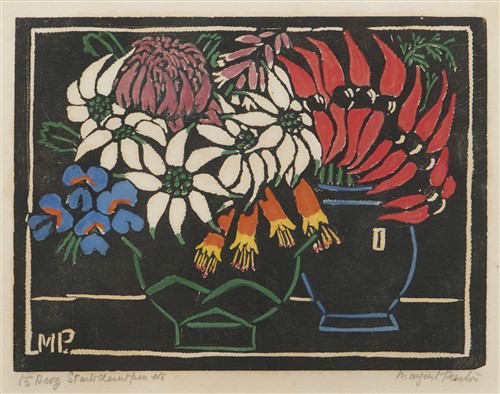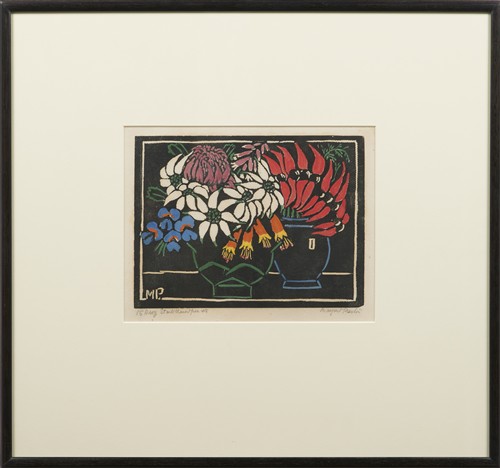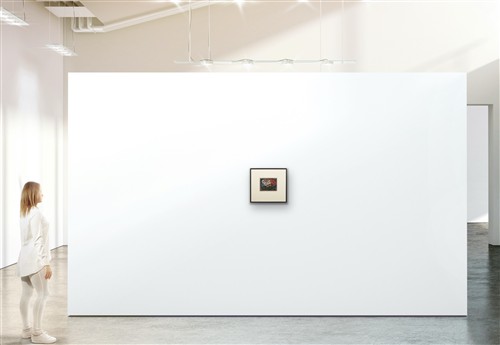Lot 27
Sturt's Desert Pea 1925
hand-coloured woodcut
signed lower right: Margaret Preston
titled and inscribed lower left
initialled in plate lower left
18.5 x 24.5cm
Estimate $10,000 - $15,000
Private collection, New South Wales
Shapiro Auctioneers, Sydney, 22 November 2022, lot 39
Private collection, Melbourne
Thea Proctor and Margaret Preston Exhibition, Grosvenor Galleries, Sydney, 18 November - 2 December 1925, cat. no. 20 (another example)
Exhibition of Woodcuts by Margaret Preston, Dunster Galleries, Sydney, September 1926, cat. no. 66 (another example)
Woman's World, Sydney, vol. 6, no. 1, January 1926, p. 64 (as "N.S.W. Wild Flowers") (illus., another example)
The Home, Sydney, vol. 8, no. 8, August 1927, p. 26 (illus., another example)
Art in Australia, Sydney, 3rd series, no. 22, December 1927, pl. 41, p. 76 (as "Australian Wild Flowers") (illus., another example)
Art in Australia, Sydney, no. 57, 15 November 1934, p. 90 (illus., another example)
Butler, R., The Prints of Margaret Preston, Australian National Gallery, Canberra, 1987, cat. no. 88, p. 109 (illus., another example)
Other examples of this print are held in the collections of the National Gallery of Australia, Canberra; and Art Gallery of South Australia, Adelaide.
Printmaking formed a large part of the modernist art movement in Australia during the 1920s and 1930s. Following the war, many female artists had studied abroad, now returning home with a wealth of artistic knowledge. Margaret Preston was one such artist, becoming a leading exponent of this modernist vision and a driving force in reshaping art in Australia.
Like many of her peers, Margaret Preston's artistic talents were not confined solely to painting. She was dedicated to progressing the celebrated medium of printmaking, developing woodcuts throughout every phase of her career. It is those of the 1920s that represent her most refined achievements. Preston skilfully utilised the inherent qualities of woodcuts to create her unique and recognisable works. She understood that the very nature of the woodcut affected the character of the image produced and employed this technique to produce single-block prints, explaining that "the wood hinders facility and compels the worker to keep forms in the compositions severe."(1) Whilst she knew the methods for multi-block colour printing, Preston most often printed a single key block in black and then added colour by hand, a practice that heightened the decorative harmony of the image while letting the composition remain boldly graphic.
'Sturt's Desert Pea' 1925 is one of the classic arrangements from this breakthrough decade. Worked from a single block, printed in black ink and hand-coloured, the image orchestrates a chorus of native flora, sturt's desert peas, flannel flowers and waratahs. Her focus on distinctly local species reflected a broader search for a national identity in the visual arts. Rather than presenting flowers as a decorative form, Preston imbued them with cultural weight, making them symbols of place and belonging.
Her project in these years went beyond decoration. Preston consistently called for the development of an art that reflected the forms, colours and motifs of the local environment. In 1924 she wrote in Art in Australia on "The Indigenous Art of Australia", encouraging artists to draw inspiration from Aboriginal design in shaping a truly national style, "I have studied the aboriginal's art and have applied their designs to the simple things of life, hoping that the craftsman will succeed where, until now, the artist has certainly failed".(2) She returned to the subject in 1930 with a practical essay on applying such designs. These writings, together with her prints of native flora such as 'Sturt's Desert Pea', highlight her ambition to establish a modern visual language that was uniquely her own.
The women artists of the 1920s and 1930s, in many ways, championed the modernist movement and were major contributors to the development of Australian art. The prints of Margaret Preston stand the test of time and sing to their own accord, reflecting pure passion for art and her perseverance through this transformative period. First shown in Sydney soon after it was made, 'Sturt's Desert Pea' remains emblematic of Preston's achievement as a union of rigorous craft, modernist design and an enduringly Australian subject.
Hannah Ryan
Senior Art Specialist
(1) Grant, K., In Relief, Australian Wood Engravings, Woodcuts and Linocuts, The National Gallery of Victoria, 1997, p. 30
(2) Preston, M., 'The Indigenous Art of Australia', Art in Australia, Sydney, 3rd series, no. 11, March 1925, p. 52
© Margaret Preston/Copyright Agency, 2025
Women Artists
AUCTION
Sale: LJ8788
6:00pm - 22 September 2025
Hawthorn
VIEWING
Fri 19 - Sun 21 September, 10 - 4pm
2 Oxley Rd Hawthorn VIC
CONTACT
Hannah Ryan
hannah.ryan@leonardjoel.com.au
SIMILAR ITEMS
Lot 22
VIDA LAHEY (1882-1968) Brisbane to Southbank c.1930 oil on plywood 24.5 x 29.5cm
Estimate: $40,000-50,000
Lot 10
NORA HEYSEN (1911-2003) Still Life, Spring Bunch 1947 oil on canvas laid on board 45 x 37cm
Estimate: $15,000-20,000
Lot 30
EMMA MINNIE BOYD (1858-1936) Children at Sandringham c.1897 oil on canvas 80 x 147cm
Estimate: $12,000-20,000
Lot 43
MIRKA MORA (1928-2018) Ports and Harbours 1978 embroidery thread, beads, synthetic polymer paint on cotton and synthetic textile bac...
Estimate: $12,000-18,000


